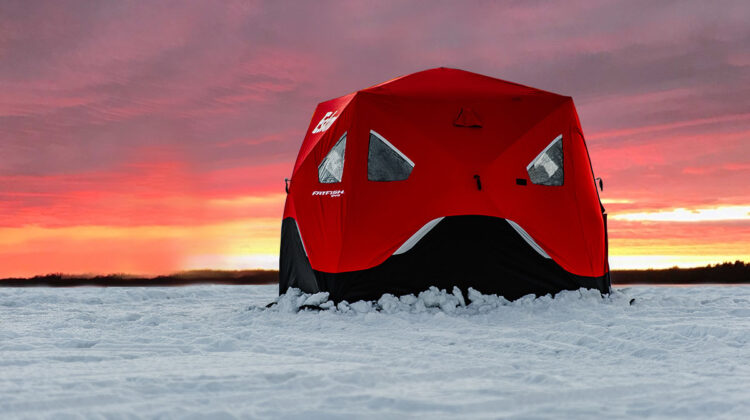
Ice fishing is more than just a hobby; it’s a way for anglers to embrace the beauty and challenges of winter while pursuing their passion. When it comes to ice fishing, a crucial element often overlooked is the choice of an ice fishing tent. Your shelter on the frozen expanse can make or break your experience, and with various types available, including pop-up, flip-over, and hub-style tents, making the right choice requires a deep understanding of each.
In this comprehensive guide, we will delve into the intricacies of these different types of ice fishing tents, exploring their distinct advantages and disadvantages. Additionally, we’ll discuss key factors such as size, portability, insulation, and setup time, providing you with the knowledge needed to make an informed decision for your next ice fishing adventure.
Types of Ice Fishing Tents
First thing first, let’s explore the types of Ice Fishing Tents:
1. Pop-Up Tents
Pop-up ice fishing tent is the go-to choice for many anglers seeking convenience and ease of use. These tents are constructed with lightweight materials and feature a collapsible frame that allows for quick assembly by simply popping them open. The instant shelter they provide is invaluable in rapidly changing weather conditions. The advantages of pop-up tents lie in their portability and hassle-free setup, making them an excellent choice for solo anglers or those who frequently change fishing spots. However, their downside becomes apparent in extreme cold, as their design may compromise insulation, potentially leading to a less comfortable fishing experience.
2. Flip-Over Tents
Designed with a sled-like base, flip-over ice fishing tents offer a unique blend of portability and convenience. Anglers can tow these tents to their chosen fishing location, and once there, they can easily flip the tent over, creating a sheltered space. The sled base also serves as a practical storage solution for fishing gear, eliminating the need for additional carrying equipment. Flip-over tents provide better insulation compared to pop-up tents due to their enclosed design, making them suitable for colder climates. However, their larger size and weight may impact overall portability, especially for those who prefer to move frequently across the ice.
3. Hub-Style Tents
Hub-style ice fishing tents are characterized by their spacious interiors and stability. These tents typically feature a central hub that connects multiple poles, creating a roomy, dome-like structure. Hub-style tents are ideal for group outings, accommodating several anglers comfortably. The advantages include ample space, good insulation, and the ability to withstand strong winds. While these tents offer excellent comfort, they may take longer to set up compared to pop-up or flip-over tents due to their multiple poles and larger size. Hub-style tents are particularly well-suited for those who prioritize a more stationary ice fishing experience and value the communal aspect of fishing with others.
Key Factors to Consider
Here are the key factors to consider when choosing the right Ice Fishing Tent:
Size
The size of your ice fishing tent is a critical consideration that directly impacts your overall comfort on the ice. Think about the number of anglers the tent needs to accommodate, the amount of gear you plan to bring, and the available space on the ice. A larger tent provides more room to move around, making it suitable for group outings or longer fishing sessions. However, it’s essential to balance size with portability, as a larger tent may be challenging to transport, especially for solo anglers or those who prefer to move frequently.
Portability
Portability is a crucial factor, especially if you anticipate moving across the ice regularly. Pop-up tents are renowned for their lightweight and compact design, making them easy to carry over short distances. Flip-over tents, although slightly heavier, often come equipped with sleds that enhance portability, allowing you to tow your gear effortlessly. On the other hand, hub-style tents, being larger and more complex, may require additional effort to transport, limiting their suitability for anglers on the move. Consider the distance you plan to cover and the frequency of your movements when assessing the portability of your chosen tent.
Insulation
Staying warm on the ice is paramount for an enjoyable and successful fishing experience. Insulation capabilities vary among different types of tents, with flip-over and hub-style tents generally providing better insulation due to their enclosed structures. When evaluating insulation, consider the tent’s material, design, and additional features such as insulated fabric or thermal technology. Adequate ventilation is also crucial to prevent condensation inside the tent. While pop-up tents are convenient, their open design may compromise insulation in extremely cold conditions, so it’s essential to balance convenience with the need for warmth.
Setup Time
The time it takes to set up your ice fishing tent can significantly impact your overall experience, especially in frigid conditions. Pop-up tents shine in this aspect, offering near-instant setup with their simple design. Flip-over tents also provide relatively quick assembly, as they involve flipping the shelter over the sled base and securing it in place. Hub-style tents, while offering spacious interiors, may take longer to set up due to their multiple poles and larger size. Consider your patience, experience level, and the prevailing weather conditions when choosing a tent with an appropriate setup time for your preferences.
Design Features:
- Doors: Evaluate the type and number of doors for convenience and accessibility.
- Windows: Check for windows or vents that provide ventilation and visibility.
- Storage: Look for storage options such as pockets or bags for keeping gear organized.
- Reflective Elements: Consider features like reflective stickers for visibility in low-light conditions.
End Note
Choosing the right ice fishing tent is a decision that goes beyond aesthetics—it directly influences the success and enjoyment of your winter angling adventures. Each type of tent comes with its unique set of advantages and disadvantages, and understanding these distinctions is paramount for making an informed choice based on your specific needs and preferences.
Whether you prioritize portability, insulation, size, or setup time, finding the perfect balance is key to a satisfying ice fishing experience. Consider the conditions you’ll be facing on the ice, the number of anglers in your party, and the frequency of your movements to tailor your choice to your individual requirements.

